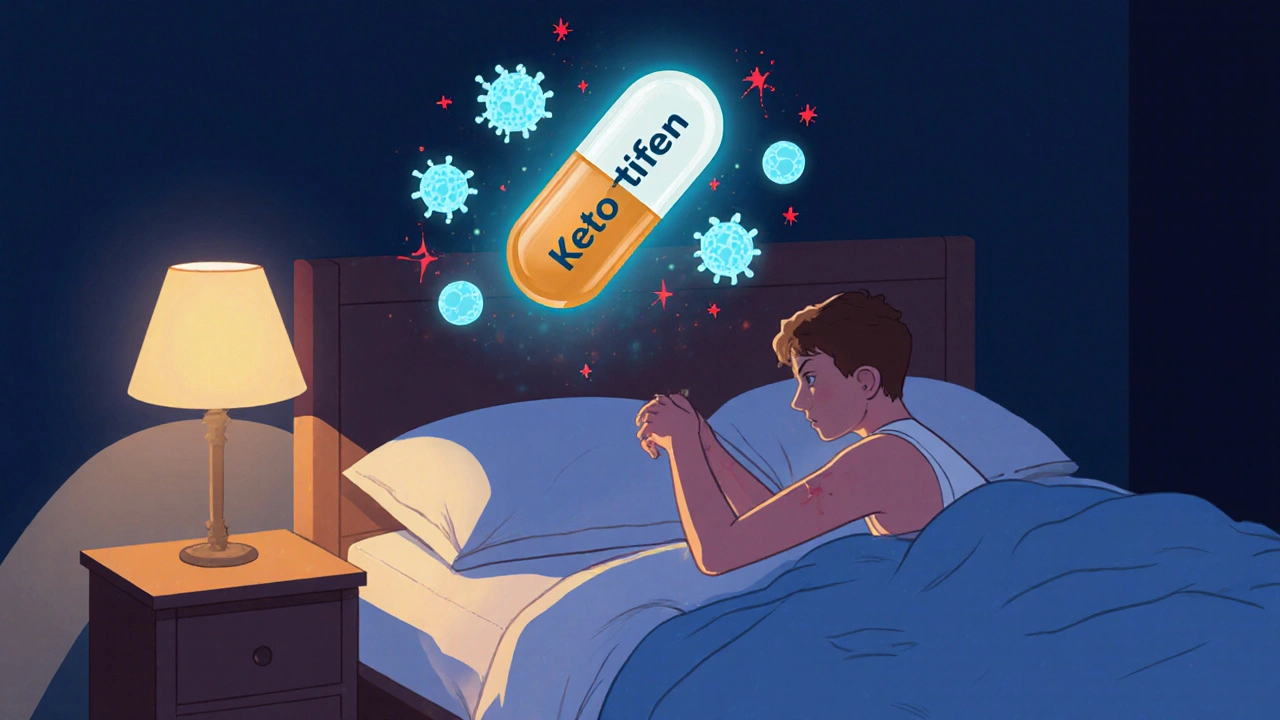
When it comes to battling allergic rhinitis or chronic urticaria, finding the right pill can feel like a guessing game. Ketotifen often sits in the mix, but dozens of other options promise faster relief or fewer side effects. This guide walks you through how ketotifen works, what you should watch for, and how it stacks up against the most common alternatives.
What is Ketotifen?
Ketotifen is a second‑generation antihistamine that also acts as a mast cell stabilizer. It was first approved in the 1970s for asthma prevention, but its anti‑itch properties have made it a staple for chronic urticaria and seasonal allergies.
How Ketotifen Works
Ketotifen blocks H1 histamine receptors, limiting the classic sneeze‑runny‑nose combo. At the same time, it thwarts mast‑cell degranulation, which reduces the release of inflammatory mediators like prostaglandins and leukotrienes. The dual action means you get both immediate relief (through H1 blockade) and longer‑term control (by stabilizing mast cells).
Key Benefits and Drawbacks
- Pros: effective for nighttime itching, useful when other antihistamines fail, available over the counter in many countries.
- Cons: can cause drowsiness, slower onset (30‑60 minutes), not ideal for people on sedating medications.
What to Look for in an Alternative
Before we compare drugs, set your own criteria. Most people weigh four factors:
- Speed of relief - How quickly does the drug start working?
- Duration - How long does a single dose protect you?
- Side‑effect profile - Sedation, dry mouth, or any rare reactions?
- Special indications - Does it treat asthma, eczema, or only nasal symptoms?
Loratadine: The Non‑Sedating Contender
Loratadine is a second‑generation, non‑sedating H1 antihistamine widely sold as Claritin. It’s a go‑to for people who need daytime alertness.
Pros include rapid onset (15‑30 minutes) and minimal drowsiness. However, it lacks mast‑cell stabilizing activity, so chronic hives may not fully respond.
Cetirizine: Stronger Blockade, Slight Sedation
Cetirizine is a second‑generation H1 antagonist that offers a bit more potency than loratadine. Marketed as Zyrtec, it works within 20 minutes and lasts about 24 hours.
It can cause mild drowsiness in 10‑15 % of users, but its higher affinity for H1 receptors makes it a solid choice for severe seasonal allergies.
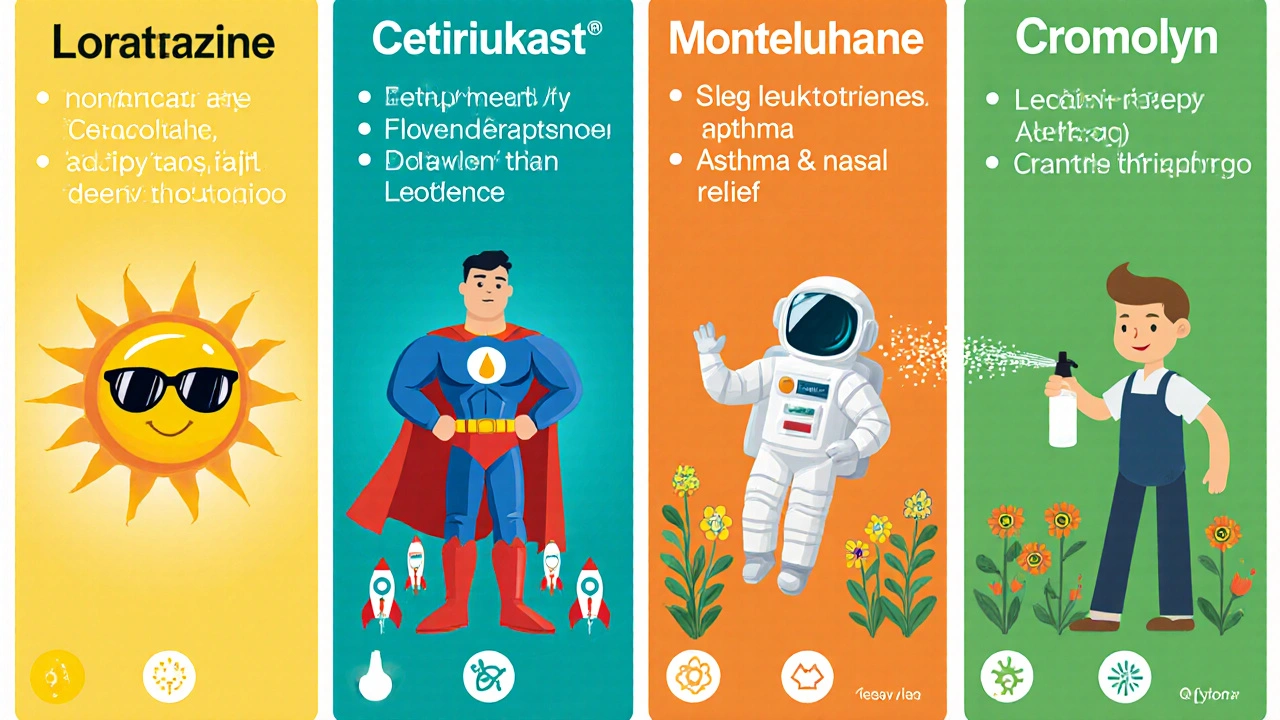
Montelukast: The Leukotriene Pathway Blocker
Montelukast is a leukotriene receptor antagonist (LTRA) best known under the brand Singulair. It’s prescribed for asthma and allergic rhinitis, especially when antihistamines alone don’t cut it.
Unlike ketotifen, montelukast works on a different inflammatory cascade, reducing nasal congestion and bronchial hyper‑reactivity without causing sedation. It’s taken once daily, but its effects may take several days to peak.
Cromolyn Sodium: Classic Mast‑Cell Stabilizer
Cromolyn Sodium is a mast‑cell stabilizer administered via inhaler or nasal spray. It prevents the release of histamine and other mediators before symptoms start.
Because it’s not absorbed systemically, side effects are rare, but you need to use it consistently - often 4‑6 times a day - to see any benefit.
Side‑by‑Side Comparison Table
| Drug | Class | Primary Indications | Typical Dose | Onset | Duration | Common Side Effects | Pregnancy Category |
|---|---|---|---|---|---|---|---|
| Ketotifen | Antihistamine + Mast‑Cell Stabilizer | Chronic urticaria, allergic rhinitis | 1 mg daily (often at night) | 30‑60 min | 12‑24 hr | Drowsiness, weight gain | B |
| Loratadine | Second‑gen H1 Antihistamine | Seasonal allergies, hives | 10 mg once daily | 15‑30 min | 24 hr | Headache, dry mouth | B |
| Cetirizine | Second‑gen H1 Antihistamine | Severe seasonal allergies, hives | 10 mg once daily | 20‑30 min | 24 hr | Mild drowsiness, fatigue | B |
| Montelukast | Leukotriene Receptor Antagonist | Asthma, allergic rhinitis | 10 mg once daily | Several days | 24 hr (steady‑state) | Headache, abdominal pain | B |
| Cromolyn Sodium | Mast‑Cell Stabilizer (nasal spray) | Allergic rhinitis, mild asthma | 2-4 sprays each nostril BID | Immediate (pre‑exposure) | Varies (needs regular use) | Nasal irritation, cough | B |
Choosing the Right Option for You
Use the following decision tree to narrow down the best fit:
- If you need night‑time relief and can tolerate mild drowsiness, Ketotifen remains a solid pick.
- If daytime alertness is a must‑have, go with Loratadine or Cetirizine. Choose cetirizine for stronger symptom control, loratadine for the cleanest side‑effect profile.
- If you have concurrent asthma or nasal polyps, Montelukast hits two birds with one stone.
- For pure mast‑cell stabilization without systemic exposure, Cromolyn Sodium (nasal spray) is the safest, provided you’re okay with multiple daily doses.
Practical Tips for Switching or Combining
- Consult your doctor before stopping any prescription, especially if you’ve been on ketotifen for chronic urticaria.
- When moving from a sedating to a non‑sedating antihistamine, taper the dose over 2‑3 days to avoid rebound itching.
- Combine an antihistamine (e.g., loratadine) with a mast‑cell stabilizer (e.g., cromolyn) if you need both rapid and preventive relief.
- Monitor for side effects during the first two weeks; keep a simple diary of symptom scores and any sleepiness.
- Women who are pregnant or planning pregnancy should stick to Category B drugs; discuss any changes with a healthcare professional.
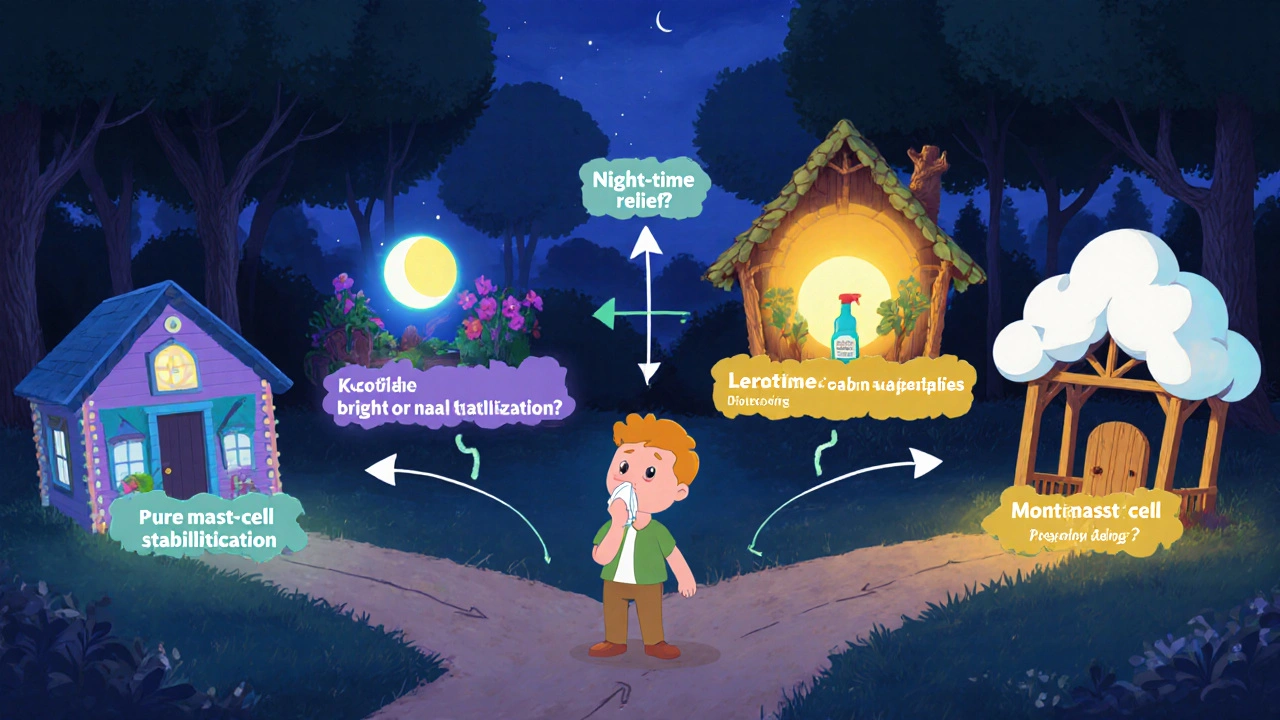
Bottom Line
Ketotifen still holds a niche for night‑time itch and patients who need that extra mast‑cell stabilizing boost. Yet the market offers several non‑sedating, faster‑acting alternatives that may better suit active lifestyles. By weighing onset, duration, side‑effects, and any co‑existing conditions, you can pick a drug that fits your day‑to‑day needs without guesswork.
Can I take Ketotifen with other antihistamines?
It’s generally discouraged because the combined sedation can be unpredictable. If you need extra control, talk to a doctor about rotating daily rather than stacking.
How long does it take for Ketotifen to start working?
Most people notice a reduction in itching within 30‑60 minutes, but full mast‑cell stabilization may require several days of consistent dosing.
Is Ketotifen safe for children?
In many countries Ketotifen is approved for children aged 2 years and older, but dosing is lower (often 0.5 mg). Always follow pediatric guidance.
What makes Montelukast different from antihistamines?
Montelukast blocks leukotrienes, another inflammatory molecule involved in allergic reactions. It therefore helps with nasal congestion and asthma symptoms that antihistamines may miss.
Can I use Cromolyn Sodium as a rescue medication?
Cromolyn is preventive, not rescue. It works best when taken before exposure to allergens. For acute flare‑ups, keep a fast‑acting antihistamine handy.


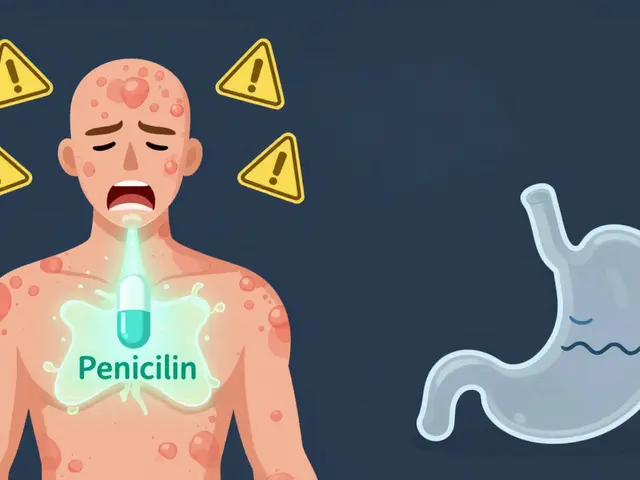
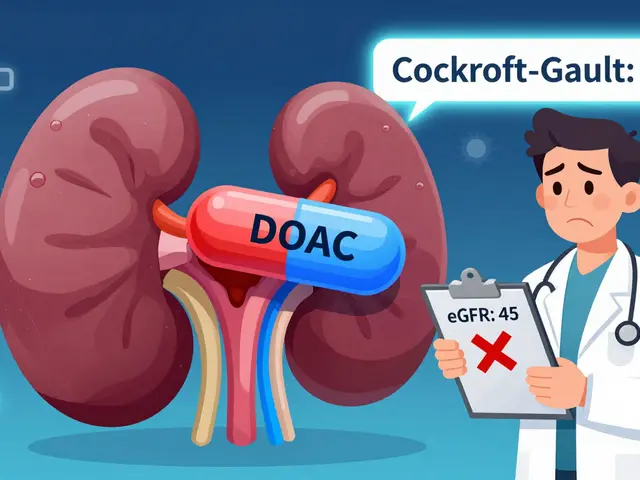


10 Comments
Ketotifen's mast‑cell stabilisation via FcεRI antagonism offers a pharmacokinetic edge, tho the drowsy side‑effect profile can be a deal‑breaker.
I hear you – finding the right antihistamine can feel overwhelming.
If nighttime itching is your main culprit, ketotifen’s sedative vibe might actually help you sleep better.
On the other hand, if you need to stay sharp for work or school, a non‑sedating option like loratadine or cetirizine could be a smoother fit.
Remember to give any new medication a week to reach steady‑state before judging its true efficacy.
Keeping a simple symptom diary can highlight which drug aligns best with your daily rhythm.
🚀 If you’re still popping old‑school ketotifen while the rest of us are on cutting‑edge LTRAs, you’re basically living in the past. 💊 Modern antihistamines like cetirizine crush the itch faster and keep you alert-no excuse to lag behind. 🌟 Upgrade your regimen and stop clinging to dinosaur meds!
The night‑time itch can feel like a wildfire in your skin.
Ketotifen douses those flames while you drift into dreams.
Every allergy battle is a chance to learn what truly supports our well‑being.
Choosing a drug isn’t just about speed; it’s about harmony with your lifestyle 🌱.
Whether you land on ketotifen’s calm night‑time guard or a bright‑hour antihistamine, trust that you’re making a thoughtful choice 😊.
One must, undeniably, appreciate the nuanced pharmacodynamics of ketotifen, a molecule that, through dual H1 antagonism and mast‑cell stabilization, offers both immediate symptomatic mitigation and prophylactic modulation.
Nevertheless, the sedative propensity, albeit modest, could, for some, constitute a non‑trivial trade‑off, particularly in vocations demanding sustained vigilance.
In sum, the therapeutic calculus is best performed with a balanced, evidence‑based perspective, and I remain, as ever, delighted to discuss such intricacies with fellow enthusiasts.
Dear fellow readers, I commend your diligence in scrutinizing the comparative merits of antihistaminic agents.
It is incumbent upon us to weigh not only pharmacokinetic onset and duration, but also the broader psychosocial implications of sedation.
Should your clinical context prioritize nocturnal pruritus without compromising daytime cognition, ketotifen may indeed constitute a judicious selection.
Conversely, for individuals necessitating uninterrupted alertness, agents such as loratadine or cetirizine are preferable 🌟.
Ketotifen occupies a unique niche among antihistamines due to its combined H1 blockade and mast‑cell stabilizing properties.
This dual mechanism translates into both rapid itch suppression and a longer‑term dampening of inflammatory cascades.
For patients with chronic urticaria that flares nightly, the sedative effect can be an ancillary benefit, allowing for uninterrupted sleep.
However, the same sedation may be detrimental for those who must operate machinery or drive shortly after dosing.
When evaluating alternatives, consider the pharmacodynamic onset: loratadine typically begins within 15‑30 minutes, whereas cetirizine may require up to 20 minutes but offers a higher receptor affinity.
Montelukast, by contrast, acts on the leukotriene pathway and therefore excels in addressing nasal congestion and bronchial hyper‑reactivity, though its therapeutic plateau may take several days.
Cromolyn sodium, administered via nasal spray, provides prophylaxis without systemic exposure, yet demands multiple daily applications to maintain efficacy.
From a pharmacokinetic standpoint, ketotifen’s half‑life of approximately 12‑24 hours permits once‑daily dosing, which can improve adherence compared to compounds requiring twice‑daily regimens.
Side‑effect profiling reveals that weight gain, though uncommon, has been reported in long‑term ketotifen users, a factor worth monitoring in pediatric populations.
Conversely, cetirizine’s most frequent adverse event is mild drowsiness, affecting roughly 10‑15 % of users, a statistic that clinicians often contextualize against the drug’s potency.
Loratadine enjoys a remarkably clean side‑effect slate, with headache and dry mouth being the most prevalent complaints, making it a frequent first‑line choice for daytime allergy sufferers.
Importantly, drug–drug interactions are minimal across this class, but combining ketotifen with other central nervous system depressants may amplify sedation.
In practice, a stepwise approach-starting with a non‑sedating antihistamine and escalating to ketotifen or an LTRA if control remains suboptimal-aligns with many guideline recommendations.
Patients with comorbid asthma may derive added benefit from montelukast, which simultaneously addresses bronchial inflammation and allergic rhinitis.
For individuals hesitant about systemic exposure, cromolyn offers a safe, though labor‑intensive, alternative that can be especially useful in seasonal allergy prophylaxis.
Ultimately, shared decision‑making, incorporating patient preferences regarding onset speed, dosing convenience, and side‑effect tolerance, will yield the most satisfactory outcome.
Ketotifen works fast but can make ya sleepy, so pick it if nite itch is worst.
Ah, thank you for the exhaustive dissertation that could double as a pharmacology textbook.
I suppose the average reddit user now needs a PhD to decide whether to take a pill.
Your stepwise algorithm, while undeniably comprehensive, feels like it was drafted by a committee of overly cautious physicians.
In reality, most of us just want a quick fix for a runny nose, not a 15‑paragraph memoir on mast‑cell biology.
Nevertheless, your emphasis on shared decision‑making is commendable, albeit delivered with the subtlety of a marching band.
Perhaps a succinct summary-‘pick ketotifen if you like to nap, otherwise try loratadine’-would serve the community better.
But who am I to judge? Maybe the extra detail helps someone who enjoys reading clinical trial data over breakfast.
In any case, thanks for the lecture; I’ll keep it in mind the next time I’m torn between a sedating antihistamine and a non‑sedating one.